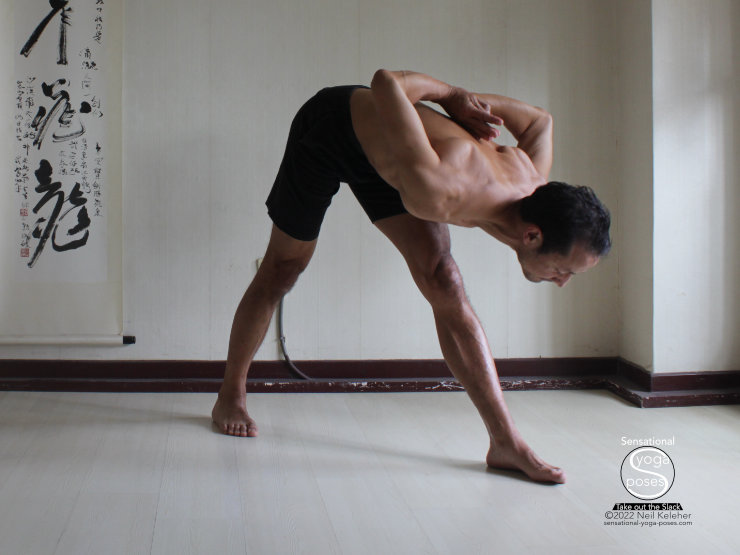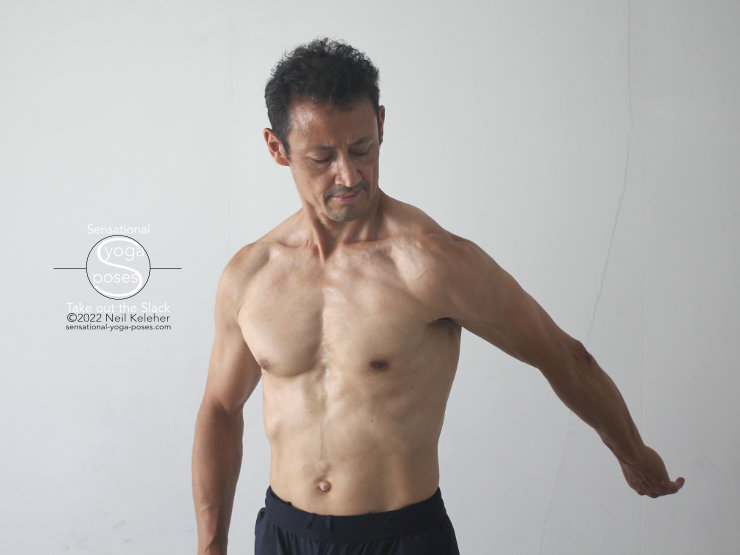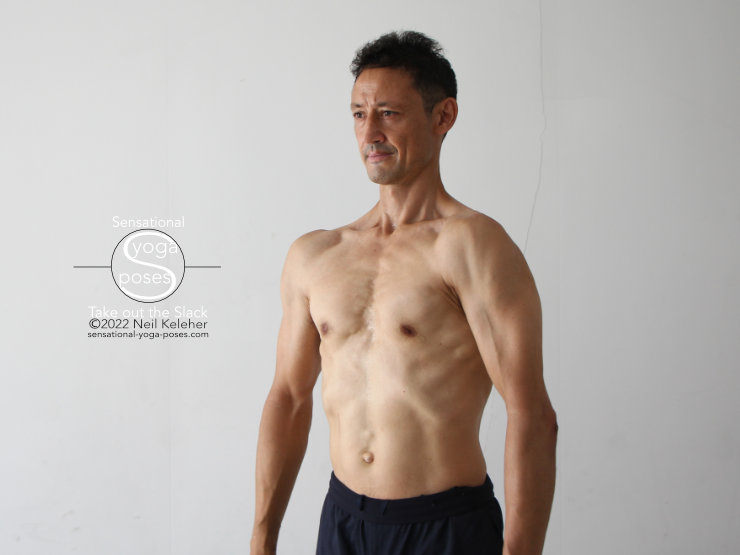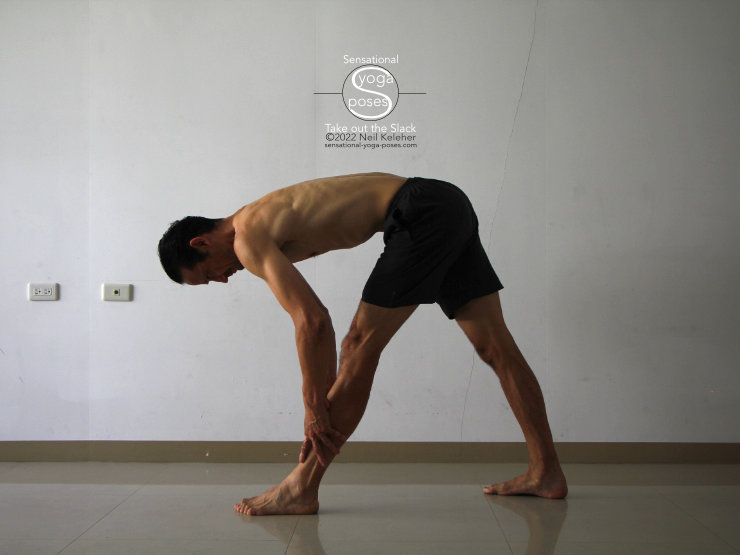Reverse Prayer Yoga Pose (Parsvottanasana)
Using muscle control for the reverse prayer hand position and the hamstring stretch
Parsvottanasana is often called reverse prayer pose. You bend forwards with your hands in prayer behind your back, with palms together and fingers pointing upwards.
One leg is forwards, the other back, with both knees straight and both feet flat on the floor.
There are two main elements to this pose. One is the reverse prayer aspect. How do you get your hands together in prayer position behind your back?
Another is the forward bending aspect.
How do you bend forwards without using your hands to support you?
The first few sections below give some biomechanical tips for working the hands into reverse prayer. After that, there are some suggestions for controlling the hips while doing the forward bend component of reverse prayer yoga pose.
Using shoulder blade control to make reverse prayer pose easier
For the reverse prayer hand position, the tendency may be to focus on the shoulders and shoulder blades. For example, you might try to protract, or spread your shoulder blades using your serratus anterior muscle. This may give you enough room to edge your palms together into prayer position, or it may not.
Another possible point of focus with respect to the shoulder blade is to focus on using your pectoralis minor muscle on either side to help pull the top of the shoulder blade forwards and down, as if trying to flip your shoulder blade over your ribcage. This can be combined with internally rotating the arm as you reach it back behind you, prior to bending your elbows and then trying to get your palms together.
Using the clavicular head of the pectoralis major
Another option is to focus on the clavicle. I only just started playing with clavicle control within the last year or so. After many years of focusing on ribcage stability and then from there, controlling the scapulae, learning to control the clavicles was an interesting and worth while endeavour.
With respect to reverse prayer, one option is to pull the top points of your shoulders forwards (the accromion processes, the peak of bone that covers the shoulder joint). You'll find this protracts your shoulder blades, but it can also cause your pectoralis major to active.
For clavicular control, you can slightly compress the collar bone towards its origin at the top of your sternum. You'll probably get some pectoral major activating, but if you play around with it, you may find that you can get your clavicular pectoralis major to activate.
This is the portion of the pectoralis major that attaches between the clavicle and the humerous. You may find that this gives you enough room to get your arms into prayer, or at least a little bit closer to it.
The Flexor Carpi Ulnaris and Extensor Carpi Ulnaris.
Two very interesting forearm muscles are the Flexor Carpi Ulnaris and Extensor Carpi Ulnaris. You can find these two muscles on either side of the ridge of your forearm (the ulna) on the pinky side.
The ridge, which is actually the edge of the ulna runs from the point of the elbow to the bump and the top of the pinky (little finger) side of the wrist.
Both of these muscles attach to the humerus, the upper arm bone, just above the elbow joint. They also attach to the ulna. At their nether ends, they attach to the carpal bones at the base of the little finger.
You can activate these muscles to stiffen the edge of your forearm. You'll find, assuming that you can do this activation, that your wrist engages also.
Once you get the activation, you can experiment with activating it with the wrist bent forwards and backwards.
Note that because those muscles cross the elbow joint, when you stiffen the edge of your forearm using those muscles, you'll probably find that you get some activatin sensation at your elbow(s) also.
So with this forearm activation, you could try protracting your shoulder blades in addition to compressing your collar bones.
You don't have to try for maximum compression. Instead, try to create just enough compression so that you can feel it. YOu can then gradually increase or decrease it as required.
Try reaching your arms back, and rotate them inwards so that as you do this your palms face inwards, then rearwards then outwards. The points of your elbows should be pointing outwards. Maintain protraction of your shoulder blades and compression of your collar bones and try to bend your elbows and at the same time bend your wrists up. Either prior to this or after this, try activating the edge of your forearms.
Once you have your hands in prayer, you can release any or all of the above activations based on feel. While they may be useful in helping you to get into reverse prayer, you may not need all of them to hold reverse prayer.
What you may find comfortable (or less uncomfortable) once your hands are in prayer is to maintain some slight collar bone compression but allow your shoulders to move back so that your shoulder blades retract. You could provide some slight resistance to this action so that you keep your serratus anterior active.
For more on how you can try setting up your shoulders for reverse prayer check out the reverse prayer article.
Centering your front leg hip joint
For the leg action in reverse prayer pose, you can try bending forwards with one leg forwards, the other back and your hands free.
To use your hip flexors, try pulling up on your front leg as you bend forwards. Keep your knee straight as you do this. You can try the same thing with your back leg. Pull your back thigh forwards.
An optional approach is to activate your calfs, hamstrings and glutes while bending forwards. While you could use these muscles to pull you back upright, you could work on lengthening them (particularly your hamstrings and glutes) while they are active, so that they control your descent into the forward bend.
Note, for either option, work at making your spine long.
You could bend your ribcage backwards while bending forwards at the hip. This may better simulate what will happen to your ribcage when your hands are in prayer. Then again, you may find that getting your hands in prayer is easier with your ribcage bent forwards.
Try both options when bending forwards with your hands on your waist.
Then try both options, if possible, with your hands in reverse prayer once you are bent forwards.
Published: 2022 05 04
Updated: 2022 05 13







